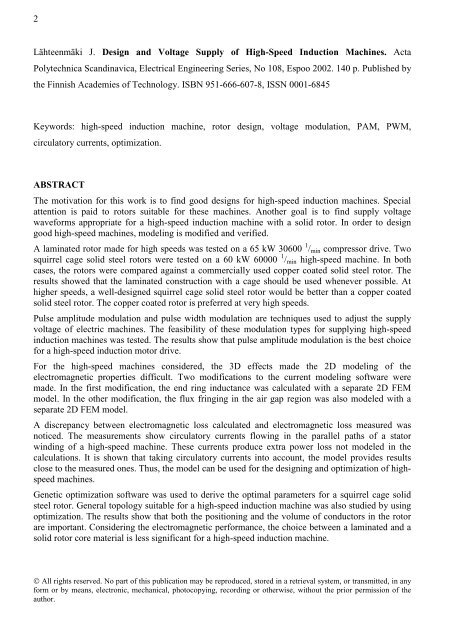Design and Voltage Supply of High-Speed Induction - Aaltodoc
Design and Voltage Supply of High-Speed Induction - Aaltodoc
Design and Voltage Supply of High-Speed Induction - Aaltodoc
You also want an ePaper? Increase the reach of your titles
YUMPU automatically turns print PDFs into web optimized ePapers that Google loves.
2<br />
Lähteenmäki J. <strong>Design</strong> <strong>and</strong> <strong>Voltage</strong> <strong>Supply</strong> <strong>of</strong> <strong>High</strong>-<strong>Speed</strong> <strong>Induction</strong> Machines. Acta<br />
Polytechnica Sc<strong>and</strong>inavica, Electrical Engineering Series, No 108, Espoo 2002. 140 p. Published by<br />
the Finnish Academies <strong>of</strong> Technology. ISBN 951-666-607-8, ISSN 0001-6845<br />
Keywords: high-speed induction machine, rotor design, voltage modulation, PAM, PWM,<br />
circulatory currents, optimization.<br />
ABSTRACT<br />
The motivation for this work is to find good designs for high-speed induction machines. Special<br />
attention is paid to rotors suitable for these machines. Another goal is to find supply voltage<br />
waveforms appropriate for a high-speed induction machine with a solid rotor. In order to design<br />
good high-speed machines, modeling is modified <strong>and</strong> verified.<br />
A laminated rotor made for high speeds was tested on a 65 kW 30600 1 /min compressor drive. Two<br />
squirrel cage solid steel rotors were tested on a 60 kW 60000 1 /min high-speed machine. In both<br />
cases, the rotors were compared against a commercially used copper coated solid steel rotor. The<br />
results showed that the laminated construction with a cage should be used whenever possible. At<br />
higher speeds, a well-designed squirrel cage solid steel rotor would be better than a copper coated<br />
solid steel rotor. The copper coated rotor is preferred at very high speeds.<br />
Pulse amplitude modulation <strong>and</strong> pulse width modulation are techniques used to adjust the supply<br />
voltage <strong>of</strong> electric machines. The feasibility <strong>of</strong> these modulation types for supplying high-speed<br />
induction machines was tested. The results show that pulse amplitude modulation is the best choice<br />
for a high-speed induction motor drive.<br />
For the high-speed machines considered, the 3D effects made the 2D modeling <strong>of</strong> the<br />
electromagnetic properties difficult. Two modifications to the current modeling s<strong>of</strong>tware were<br />
made. In the first modification, the end ring inductance was calculated with a separate 2D FEM<br />
model. In the other modification, the flux fringing in the air gap region was also modeled with a<br />
separate 2D FEM model.<br />
A discrepancy between electromagnetic loss calculated <strong>and</strong> electromagnetic loss measured was<br />
noticed. The measurements show circulatory currents flowing in the parallel paths <strong>of</strong> a stator<br />
winding <strong>of</strong> a high-speed machine. These currents produce extra power loss not modeled in the<br />
calculations. It is shown that taking circulatory currents into account, the model provides results<br />
close to the measured ones. Thus, the model can be used for the designing <strong>and</strong> optimization <strong>of</strong> highspeed<br />
machines.<br />
Genetic optimization s<strong>of</strong>tware was used to derive the optimal parameters for a squirrel cage solid<br />
steel rotor. General topology suitable for a high-speed induction machine was also studied by using<br />
optimization. The results show that both the positioning <strong>and</strong> the volume <strong>of</strong> conductors in the rotor<br />
are important. Considering the electromagnetic performance, the choice between a laminated <strong>and</strong> a<br />
solid rotor core material is less significant for a high-speed induction machine.<br />
© All rights reserved. No part <strong>of</strong> this publication may be reproduced, stored in a retrieval system, or transmitted, in any<br />
form or by means, electronic, mechanical, photocopying, recording or otherwise, without the prior permission <strong>of</strong> the<br />
author.
















